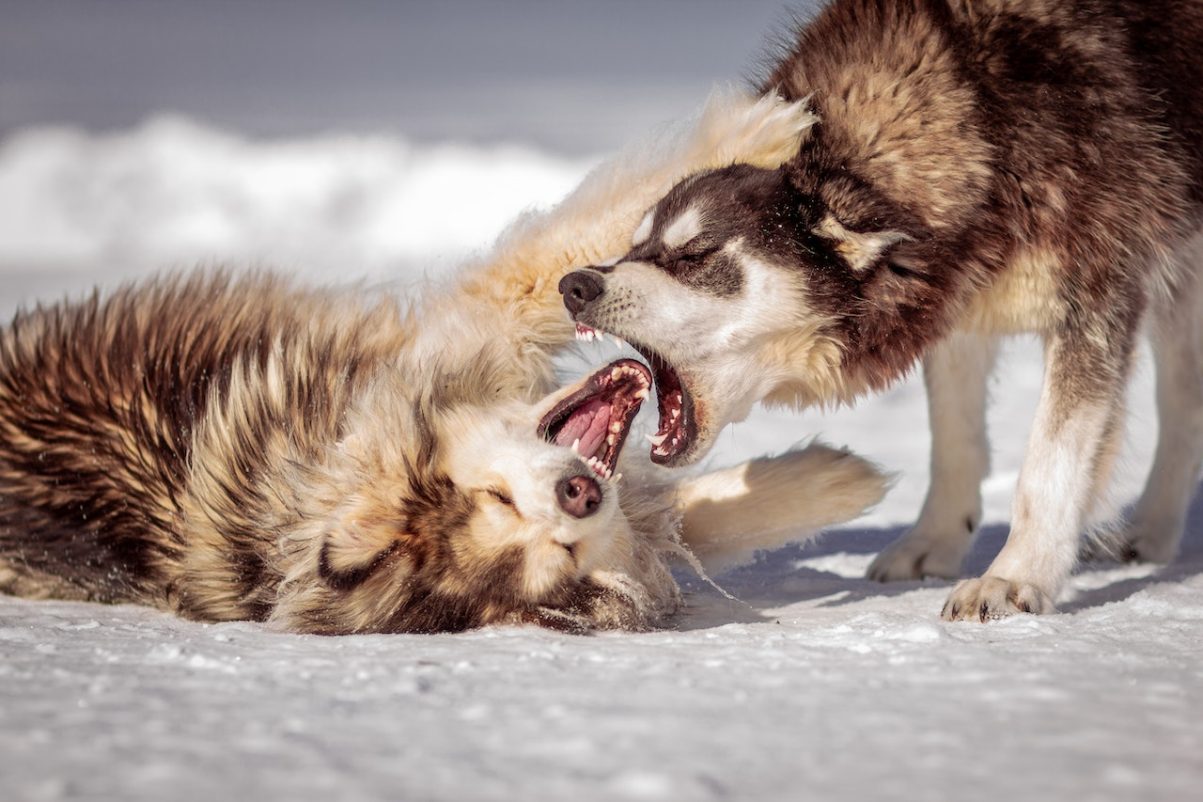As a dog lover and owner, I’ve experienced several dog behavior problems that took some patience and knowledge to overcome.
In this article I highlight five of the most common behavior problems in dogs, their causes and possible helpful tips and solutions.
5 Most Common Dog Behavior Problems
1 – Aggression
Aggression is the most common and serious behavior problem in dogs.
It is also the primary reason pet owners seek help from professional trainers, behaviorists, and veterinarians.

Aggression can manifest in a variety of behaviors, often beginning with warning signs and potentially culminating in an attack.
Signs of aggression include becoming very still and rigid, threatening barking, lunging forward, growling, showing teeth, snapping, and biting.
There are different types of aggression in dogs, including territorial, protective, possessive, and fear aggression:
- Territorial Aggression: Some dogs may attack and bite an intruder, whether friend or foe, to protect their territory;
- Protective Aggression: Dogs may display aggressive behavior when they perceive that a family member or friend is in danger;
- Possessive Aggression: Dogs may guard their possessions aggressively, from food and toys to resting spots;
- Fear Aggression: A dog may become aggressive if cornered or trapped, as they switch from a flight response to a fight response;
Solutions for Aggression
Handling aggression requires a comprehensive understanding of its triggers and underlying causes.
Once these triggers and causes are identified, then it will be possible to create a plan to modify the behavior.
But make sure you do this with the help of a professional.
The approach may involve desensitization, counter-conditioning, or positive reinforcement training.
In some cases, medication may be recommended by a vet.
Useful: Impulse Control Aggression in Dogs — What Is It and How Do We Address It.
2 – Excessive Barking
Every dog barks, but when the barking becomes too frequent or occurs at inappropriate times, it becomes a problem.
The reason behind the barking needs to be identified before seeking a solution.
Solutions for Excessive Barking
Effective solutions include training the dog to understand and respond to “quiet” commands, providing physical and mental stimulation, and avoiding triggers, if possible.
It’s also important to reward quiet behavior.
Useful: The Best Ways To Stop A Dog Barking. This Works.
3 – Destructive Chewing
Destructive chewing is a common issue, especially in puppies.
Dogs chew to explore their environment, relieve boredom, and soothe themselves.
But it is important to let them know, to teach them what they can and can’t chew.
Solutions for Destructive Chewing
Providing appropriate chew toys, puppy-proofing your home, and using deterrent sprays on furniture can all help.
Regular exercise and mental stimulation can also reduce the desire to chew destructively.
Useful: How To Stop a Dog From Chewing Everything.
4 – Separation Anxiety
Many dogs become destructive or disruptive when left alone, indicating separation anxiety.
This is a complex issue that often requires professional intervention.
Solutions for Separation Anxiety
Gradual desensitization to being alone, training to help the dog feel more secure, and sometimes medication may be required.
Creating a safe, comfortable space for the dog when alone can also help.
Useful: Separation Anxiety In Dogs. How to deal with it.
5 – Mouthing and Nipping
Mouthing and nipping are normal behaviors in dogs, especially puppies.
But if we do not manage and address this issue properly it can grow into a much serious problem once they get older.
Solutions for Mouthing and Nipping
Teaching bite inhibition from a young age, redirecting to appropriate chew toys, and using positive reinforcement training methods can be effective in curbing this behavior.
Useful: How to Get a Dog to Stop Nipping. This Will Work.
Dog Behavior Problems – Final Thoughts
It’s important to remember that patience, consistency, and understanding are key when addressing any dog behavior problem.
Useful: Abnormal Dog Behavior. A Helpful And Useful Guide.Remember that most of the times, when your dog has changes in behavior, these are caused by specific triggers or health issues.
Dogs can show symptoms that might seem similar to human bipolar disorder, like periods of hyperactivity followed by periods of lethargy, but at the end, these can also be signs of various health issues, including hypothyroidism, Cushings disease, or certain types of infections.
This is why, at the end, if a dog is showing weird behaviors, the best thing to do is to check with your vet or a dog behaviorist.
They can help diagnose any underlying health issues that might be causing these behaviors and can provide the appropriate treatment or management strategies.
And if needed, there are various medications available that can help manage behavioral issues in dogs.
There are medications can help with conditions such as separation anxiety, compulsive behavior, or aggression in dogs.
These medications are typically used together with techniques to modify the dog’s behavior.
But give medications to your dog without the help/supervision of a vet, cause they can have serious side effects.
And besides, what medication to use can vary a lot from dog to dog.
At the end, if you are facing behavioral issues with your dog, we advise checking with your vet first, in order to draw a proper plan of action.

